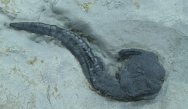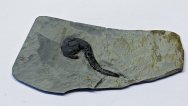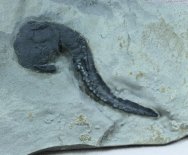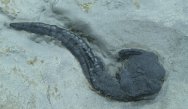Castericystis
vali
Phylum Echinodermata,
Within Homalozoa Class Homoiostelea (solutes), Order Cornuta (this
is one view of the classification among the enigmatic group)
Geological
Time: Early Middle Cambrian (~520 million years ago)
Size (25.4
mm = 1 inch): Fossil is 40 mm long (if straight) on a
40 mm by 95 mm matrix.
Fossil Site:
Marjum Formation, House Range, Millard County, Utah
Fossil Code:
STF06
Price: Sold
|  Description:
The extinct carpoids are an informal grouping of Paleozoic fossils
that closely resemble echinoderm, but lack radial symmetry. However,
their classification remains controversial and they have been
variously postulated to have been stem groups of other groups
such as the basal deuterostomes or the craniates, tunicates,
acraniates and chordates. Carpoids are known from the Middle
Cambrian to Early Devonian. Description:
The extinct carpoids are an informal grouping of Paleozoic fossils
that closely resemble echinoderm, but lack radial symmetry. However,
their classification remains controversial and they have been
variously postulated to have been stem groups of other groups
such as the basal deuterostomes or the craniates, tunicates,
acraniates and chordates. Carpoids are known from the Middle
Cambrian to Early Devonian.
Coming
from Utah’s Marjum Formation,
this fine carpoid fossil dates to the Middle Cambrian when
these animals first appeared.
The pictures speak to the strange body plan of this enigmatic
creature. These small strange creatures had spiny tails, bulbous
heads and were covered with spines. Having a body supported
by calcitic plates, they resemble modern echinoderms such as
starfish
and their relatives. Some researchers believe that the common
ancestor of echinoderms and vertebrates was a carpoid which
is supported by the many shared features of echinoderms and vertebrate
embryonic development.
Carpoids
are distinct from all other animals, extant and extinct,
because of their complete asymmetry, internally and externally.
All the other examples I have had were the smaller Castericystis
sprinklei from the Wheeler Formation. These are far more
rare, with this representing the first I have had.
|
|



